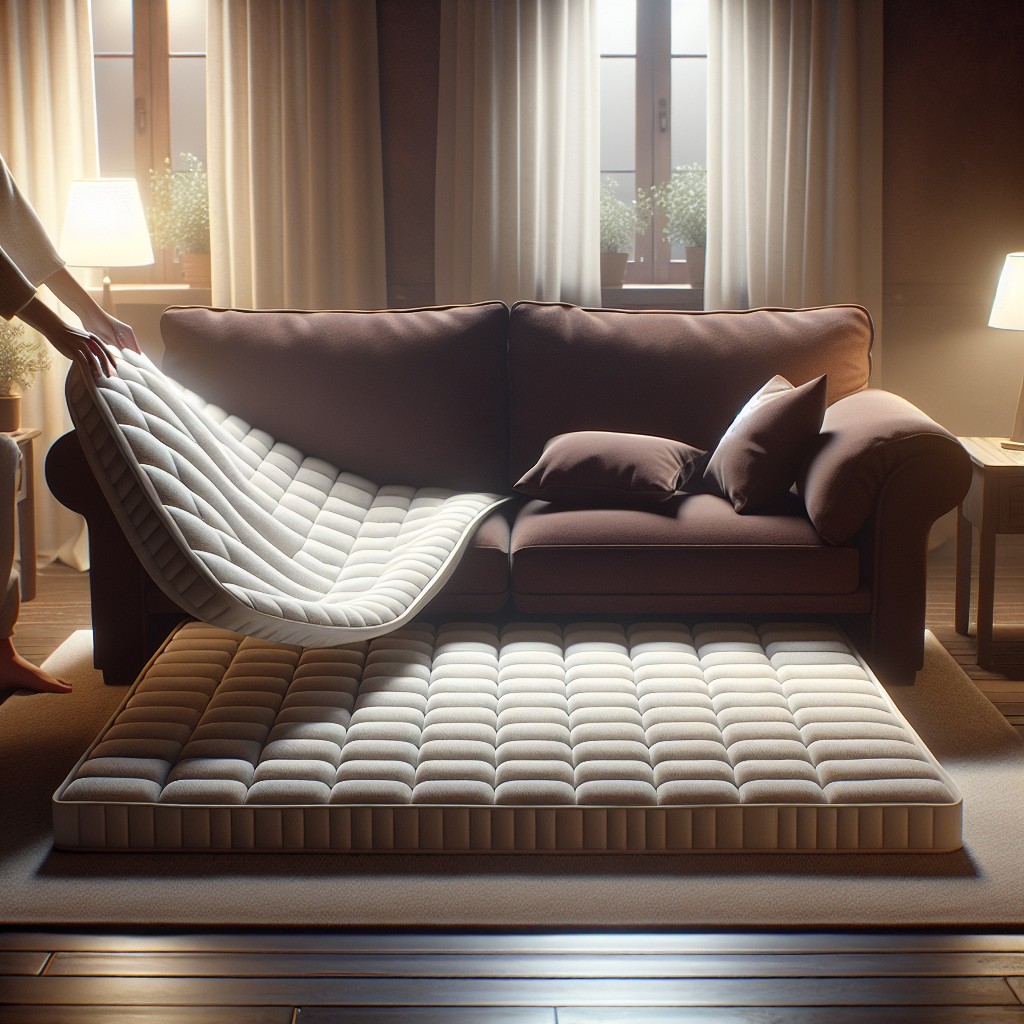Last updated on
Transforming a simple couch into a cozy sleep sanctuary becomes enticingly easy because of a few practical steps, which this informative guide reveals in detail.
Transforming a couch into a slumber-worthy haven doesn’t require magic, just a touch of thoughtful preparation. Whether you’re accommodating a guest or carving out a cozy nook for yourself, a comfortable sleep on a couch is attainable.
By priming the surface, selecting a supportive mattress topper, choosing soft, breathable bedding, investing in a superb pillow, and draping with sumptuous blankets, you can convert any couch into a dreamy sleep sanctuary.
Ready to turn your living room staple into a nightly retreat? Let’s unlock the secrets to making your couch a place where sleep comes blissfully easy.
Key takeaways:
- Prepare the couch surface: Clean, flip cushions, add support.
- Add a supportive mattress topper: Memory foam or latex, measure and secure.
- Select comfortable bedding: Soft, breathable fabrics and cozy layers.
- Use a high-quality pillow: Choose based on sleeping position and support needs.
- Overlay with soft blankets: Choose plush materials and layer for temperature control.
Table of Contents
Prepare the Couch Surface

Ensuring the couch base is even and smooth is crucial for a restful sleep. Begin by removing any large crumbs or debris and vacuuming the surface to create a clean area.
If the couch has removable cushions, flip them to find a firmer or less worn-down side. This can help prevent sinking or uneven pressure points.
Slipping a piece of plywood between the cushions and the frame may also provide additional support for those needing a firmer sleeping surface.
Seal any gaps where cushions meet with small towels or a folded blanket to prevent sinking into the crevices during the night.
These simple adjustments can greatly enhance overall comfort.
Add a Supportive Mattress Topper

A mattress topper can transform any couch into a cozy bed. It provides additional cushioning to soften a firm sofa and evens out any lumps or dips.
When shopping for one, memory foam is a top choice due to its ability to contour to your body, offering both comfort and support.
For those who prefer a firmer surface, a latex topper can be ideal, as it tends to be more supportive and durable.
Thickness varies, but a topper between two to four inches can make a significant difference.
Look for a topper with a removable cover for easy cleaning.
Before purchasing, measure your couch to ensure the topper fits well, as an overhanging topper can slip off during sleep.
Lastly, consider securing the topper with straps or a fitted sheet to keep it in place throughout the night.
Select Comfortable Bedding

Choosing the right sheets and blankets can transform a couch sleep experience. Opt for soft, breathable fabrics such as cotton or bamboo that feel gentle against the skin and help regulate temperature.
Consider a fitted sheet to keep the base layer snug and in place. Additionally, layering with a cozy comforter or duvet can provide both warmth and a plush sensation, mimicking the comfort of a traditional bed.
A sleeping bag can be a practical alternative, offering easy setup and takedown. Remember, the tactile experience is key—select textures that invite relaxation and contribute to a soothing sleep environment.
Use a High-quality Pillow
Investing in a good pillow can significantly transform your couch-sleeping experience. Opt for one that aligns with your preferred sleeping position—firmer for side sleepers, medium for back sleepers, and softer for stomach sleepers.
Memory foam adapts to your shape, providing bespoke support, while down offers a plusher feel.
If neck pain is a concern, consider ergonomic options designed to maintain the natural curve of your cervical spine.
Regularly fluffing and replacing pillows ensures they retain their supportive properties, enhancing your comfort level when the couch becomes your bed for the night.
Overlay With Soft Blankets
Invest in plush blankets that enhance comfort and provide warmth. Choose materials like fleece or cotton for their softness and breathability.
A weighted blanket can offer a sense of security and may help facilitate deeper sleep.
Ensure that the size is appropriate, fitting the couch without excessive overhang, to avoid tangling during the night.
Layering thinner blankets allows for easy adjustment to temperature changes, keeping the sleeping experience cozy and uninterrupted.
Remove Backrest Cushions for Added Space
Maximizing your surface area is key when transforming a couch into a sleep oasis. Without the hindrance of backrest cushions, you gain precious inches, allowing for a more spacious and flatter surface, akin to a traditional bed.
Here are several points to keep in mind:
- Store the cushions in a safe spot to avoid tripping hazards if you need to get up in the night.
- Fluff any remaining seat cushions to ensure even support now that the backrests are gone.
- If gaps form between seat cushions, consider filling them with small pillows or rolled-up blankets for a seamless sleeping area.
- For couches that aren’t too deep, the extra space from removing backrest cushions could provide room to stretch out fully, enhancing comfort.
Position Couch Cushions for Support
Maximizing your comfort on a couch often requires some strategic placement of couch cushions. Use the available cushions to create a make-shift headboard for neck and head support, akin to what you’d find in a traditional bed setup.
If there’s a gap between the couch’s back and seat cushions, tuck a smaller pillow or rolled-up blanket in this space to prevent any sinking feeling throughout the night.
For those who may need extra lumbar support, placing a cushion at the small of your back can make a world of difference.
If the arm of the couch is not cushioned, wrapping a soft throw or towel around it can provide a softer surface for your arms or head.
By adjusting the cushions to your body’s contours, you can transform a rigid sofa into a cozy nest that encourages restorative sleep.
Control for Light and Noise Disturbances
Ensuring a dark, quiet environment can greatly improve sleep quality on a couch. Blackout curtains or an eye mask can block out unwanted light, effectively signaling to your body that it’s time to wind down. For auditory comfort, consider earplugs or a white noise machine to drown out disruptive sounds.
These steps help create a conducive sleeping atmosphere, even in a living room setting.
Maintain a Clean Sleeping Area
Ensuring your couch is free from dust and debris not only promotes hygiene but enhances comfort. Regularly vacuum the cushions to remove crumbs or pet hair. Use a lint roller if necessary for persistent fuzz.
If the couch has removable covers, wash them according to the care label instructions. For leather couches, a damp cloth with a mild cleanser can be used for spot cleaning. Also, consider placing a washable sofa cover over the couch which can be easily removed and laundered, keeping the sleeping surface fresh and inviting.
Regular upkeep will contribute to a pleasant rest environment and prolong the life of your couch.
Manage the Room Temperature
Ensuring a conducive environment includes keeping the room at an ideal temperature, typically between 60-67 degrees Fahrenheit for optimal sleep.
Consider a programmable thermostat to automate the process for overnight comfort.
On warmer nights, a stand-alone fan can promote air circulation, while a space heater adds warmth during colder times without overheating the entire home.
Regardless of the season, maintain a steady temperature to avoid sleep disruptions and foster a restful night on your couch.




